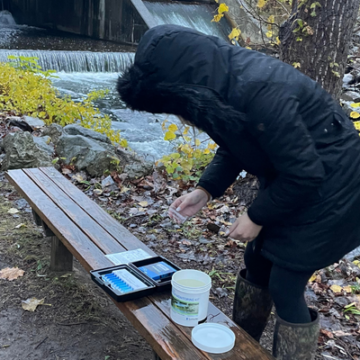UM-Flint professor, high school students to share water quality research discoveries

What do you call it when students from a trio of area high schools are paired with a biology lecturer from a local university to study water quality of a nearby body of water?
Well, whatever it is, it's certainly not your average high school science class.
Instead, the collaboration between students from Hartland, Fowlerville and Brighton and the University of Michigan-Flint's Jill Slater, is preparing the teens for college while they make important scientific discoveries in their own backyard.
The group, brought together by UM-Flint's collaborative partnership with mid-Michigan schools – known as the Dual Enrollment Educational Partnerships – is working to study the water quality of North Ore Creek, which is located right behind Hartland High School.
The DEEP initiative allows students to earn college credits while they're still attending high school.
Discoveries in North Ore Creek include benthic macroinvertebrates, which are insects that live in the mud or silt found at the bottom of a river, and positive identification of an iron bacteria-containing seep. Slater said the discovery of the macroinvertebrates is a piece of good news and shows signs of a healthy ecosystem, whereas the discovery of the seep containing the iron bacteria is more neutral.
"The students found the seep while walking along the riverbank, and since they're the first ones to identify it, they're studying to determine whether its oily sheen is human-made or naturally occurring," said Slater.
Slater, who has been teaching DEEP courses like the one in Livingston County for about nine years, said that students also found evidence of increased numbers of E. coli and coliforms based on comparative data from counts conducted by the Michigan Department of Environmental Quality. Slater said there are good and bad types of E. coli, and the number that the students found would be considered as a health threat. "This discovery is definitely problematic," said Slater.
She added that now that the students have made these discoveries, they'll be working to analyze more data. The group that found the iron bacteria seep will be studying geological features around the site to help determine what factors are contributing to the seep. The group working with the E. coli data will be tasked with finding aerial photos in order to help them identify a potential source to determine why the numbers have increased.

"Having the students gather and analyze significant amounts of data and come up with their own hypotheses teaches them the skills of a scientist," said Slater.
Another important part of the scientific process is presenting research, and the students have a unique opportunity to do just that. Typically, the university would host DEEP students on campus in order for them to present their projects, but this time, students will be presenting in front of several Livingston County officials, including Matt Bolang, acting director/health officer from the Livingston County Health Department; Mitch Dempsey, environmental projects manager with the Livingston County Drain Commissioner's Office; and Sarah Baker, who represents Friends of the Shiawassee River.
"These young, budding scientists are really rising to the challenge of presenting their research to professionals and are very excited to do so," said Slater.
For more information about the university's DEEP program, visit its website.
Related Posts
No related photos.
Madeline Campbell
Madeline Campbell is the communications specialist for the College of Arts & Sciences. She can be reached at mciak@umich.edu.